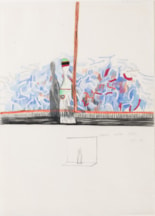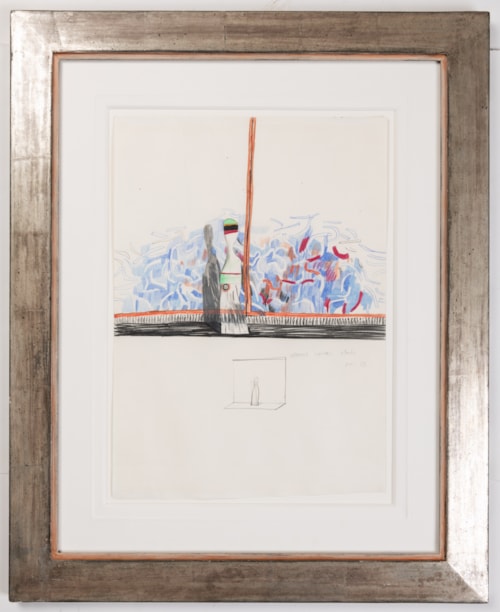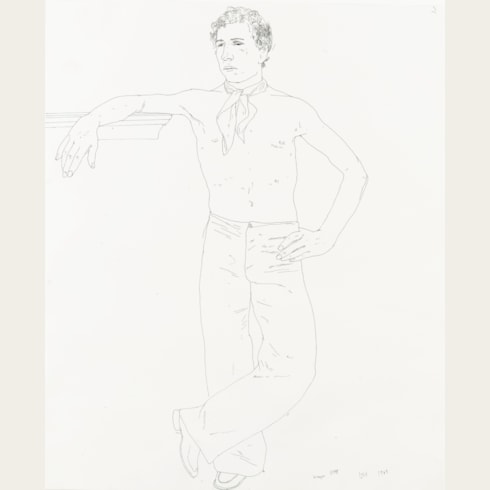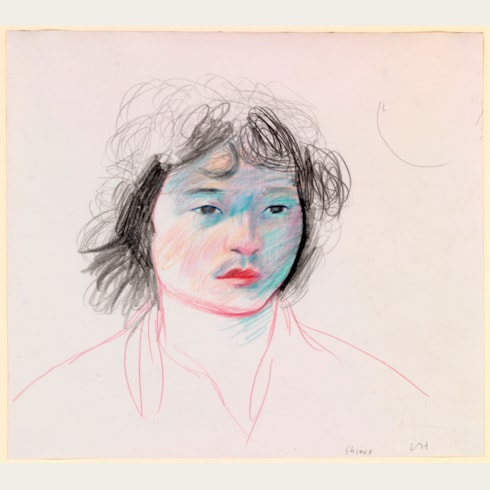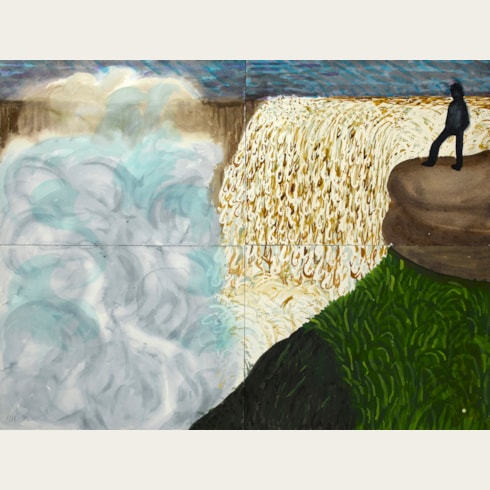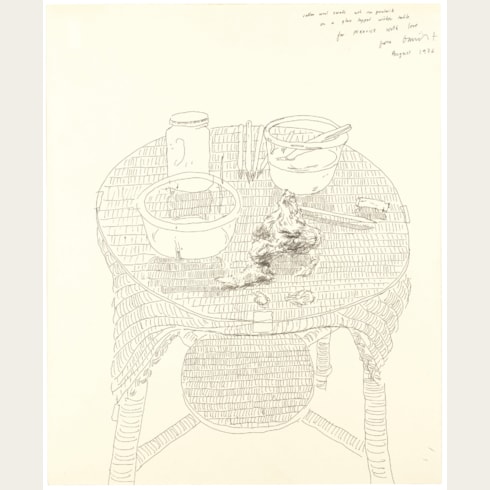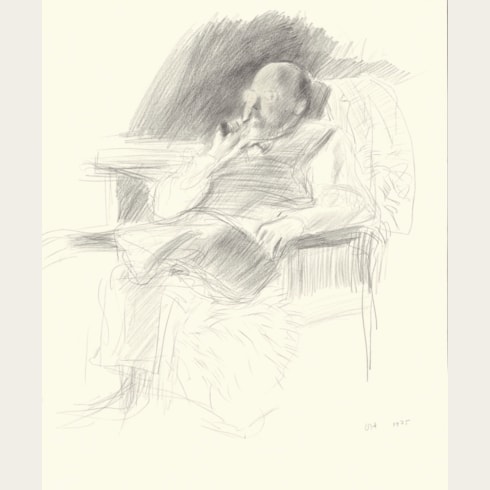David HOCKNEY
(Bradford Born 1937)
Coloured Curtain Study
Pencil and coloured chalks on white paper.
Signed with initials, titled and dated coloured curtain study / DH. 63. at the lower right.
Inscribed (in a different land) Lambeth(?) on the verso.
447 x 320 mm. (17 5/8 x 12 5/8 in.)
Signed with initials, titled and dated coloured curtain study / DH. 63. at the lower right.
Inscribed (in a different land) Lambeth(?) on the verso.
447 x 320 mm. (17 5/8 x 12 5/8 in.)
This large drawing is related to David Hockney’s seminal painting Still Life with Figure and Curtain of 1963, in the collection of the Peter Stuyvesant Foundation. The painting, one of the artist’s most significant works of the early 1960s, has been described as ‘an exercise in abstraction. The picture-plane is filled with a hanging patterned curtain in front of which stands a mannikin-like figure, some fruit, and [a] vase of flowers.’
As Hockney has recalled, ‘Immediately after The Hypnotist I painted Still Life with Figure and Curtain, which was done in a very formal way. Soon after I began it, I went in the National Gallery one day and had a very rare experience of seeing. I thought I knew the National Gallery and all the pictures very well, but in 1963 they’d bought a group of paintings by the seventeenth-century artist Domenichino. I wandered in and found them in a room and they thrilled me, because they were things I could use. I suddenly saw what they were about. The moment these pictures revealed themselves, I realized my ideas were far from being new. It wasn’t their subject matter from Greek mythology that interested me, but the fact that they really seemed like trompe-l’oeil painting. They were paintings made to look like tapestries made from paintings, already a double level of reality. All of them had borders round and tassels hanging at the bottom and perhaps an inch of floor showing, making the illusionistic depth of the picture one inch. In one of them, Apollo Killing Cyclops, the tapestry was folded back a little…and in front of this was a dwarf. I don’t really know who he is or what it was meant to be about but the doubling back from the spectator interested me.’
The motif of a curtain appeared in a number of Hockney’s paintings during the first half of the 1960s. As has been noted, ‘In a seemingly perverse way Hockney began to turn formalist principles to theatrical ends. The quintessentially theatrical image of a curtain…began to assume prominence around 1963 in such pictures as Still Life with Figure and Curtain and The Hypnotist.’ The artist seems to have been particularly interested in the theatrical concept of a curtain in his compositions: ‘From 1963 until 1965 the curtain is used more fully in all sorts of ways – for decoration, for composition, for narrative and for showing different types of reality. In general what attracted the artist about curtains was that “they are always about to hide something, or about to reveal something.”’
Other paintings with a curtain motif from 1963 include Seated Woman Drinking Tea, Being Served by a Standing Companion, recently acquired by the Museum of Modern Art in New York, as well as Play within a Play and Closing Scene, both in private collections. On the subject of curtains, Hockney has further commented that ‘The form of the curtain first made me interested in it as a subject, and then it dawned on me that it could be even more interesting because it was flat – the magic word again. A curtain, after all, is exactly like a painting; you can take a painting off a stretcher, hang it up like a curtain; so a painted curtain could be very real. All the philosophical things about flatness, if you go into it, are about reality, and if you cut out illusion then painting becomes completely ‘real’. The idea of the curtains is the same thing.’
The first owner of this drawing was the art historian and pioneering curator Ronald Alley (1926-1999), who worked at the Tate Gallery for thirty-five years and was its first Keeper of the Modern Art collection, holding the position between 1965 and his retirement in 1986. Alley joined the Tate in 1951 and during his tenure there was particularly instrumental in acquiring Modern American artworks for the museum, including works by Carl André, Jasper Johns, Robert Rauschenberg and Mark Rothko. He curated exhibitions of the work of, among others, Barbara Hepworth, Patrick Heron, Victor Pasmore, William Roberts, Graham Sutherland and Francis Bacon, of whom he also wrote the first catalogue raisonné, published in 1964. He also produced books on Paul Gauguin, Ben Nicholson, Pablo Picasso, Henri Rousseau and William Scott. Alley lent this drawing to the important retrospective exhibition of Hockney’s early works at the Whitechapel Art Gallery in London in 1970.
The present sheet was later in the collection of Erich Sommer (1921-2004), who assembled a fine group of 20th Century British works over a period of some twenty years. Sommer lent Coloured Curtain Study to the 1978-1980 travelling exhibition David Hockney: Prints and Drawings. Most recently, this drawing belonged to another prominent collector, the businessman and philanthropist Jack Kirkland.
As Hockney has recalled, ‘Immediately after The Hypnotist I painted Still Life with Figure and Curtain, which was done in a very formal way. Soon after I began it, I went in the National Gallery one day and had a very rare experience of seeing. I thought I knew the National Gallery and all the pictures very well, but in 1963 they’d bought a group of paintings by the seventeenth-century artist Domenichino. I wandered in and found them in a room and they thrilled me, because they were things I could use. I suddenly saw what they were about. The moment these pictures revealed themselves, I realized my ideas were far from being new. It wasn’t their subject matter from Greek mythology that interested me, but the fact that they really seemed like trompe-l’oeil painting. They were paintings made to look like tapestries made from paintings, already a double level of reality. All of them had borders round and tassels hanging at the bottom and perhaps an inch of floor showing, making the illusionistic depth of the picture one inch. In one of them, Apollo Killing Cyclops, the tapestry was folded back a little…and in front of this was a dwarf. I don’t really know who he is or what it was meant to be about but the doubling back from the spectator interested me.’
The motif of a curtain appeared in a number of Hockney’s paintings during the first half of the 1960s. As has been noted, ‘In a seemingly perverse way Hockney began to turn formalist principles to theatrical ends. The quintessentially theatrical image of a curtain…began to assume prominence around 1963 in such pictures as Still Life with Figure and Curtain and The Hypnotist.’ The artist seems to have been particularly interested in the theatrical concept of a curtain in his compositions: ‘From 1963 until 1965 the curtain is used more fully in all sorts of ways – for decoration, for composition, for narrative and for showing different types of reality. In general what attracted the artist about curtains was that “they are always about to hide something, or about to reveal something.”’
Other paintings with a curtain motif from 1963 include Seated Woman Drinking Tea, Being Served by a Standing Companion, recently acquired by the Museum of Modern Art in New York, as well as Play within a Play and Closing Scene, both in private collections. On the subject of curtains, Hockney has further commented that ‘The form of the curtain first made me interested in it as a subject, and then it dawned on me that it could be even more interesting because it was flat – the magic word again. A curtain, after all, is exactly like a painting; you can take a painting off a stretcher, hang it up like a curtain; so a painted curtain could be very real. All the philosophical things about flatness, if you go into it, are about reality, and if you cut out illusion then painting becomes completely ‘real’. The idea of the curtains is the same thing.’
The first owner of this drawing was the art historian and pioneering curator Ronald Alley (1926-1999), who worked at the Tate Gallery for thirty-five years and was its first Keeper of the Modern Art collection, holding the position between 1965 and his retirement in 1986. Alley joined the Tate in 1951 and during his tenure there was particularly instrumental in acquiring Modern American artworks for the museum, including works by Carl André, Jasper Johns, Robert Rauschenberg and Mark Rothko. He curated exhibitions of the work of, among others, Barbara Hepworth, Patrick Heron, Victor Pasmore, William Roberts, Graham Sutherland and Francis Bacon, of whom he also wrote the first catalogue raisonné, published in 1964. He also produced books on Paul Gauguin, Ben Nicholson, Pablo Picasso, Henri Rousseau and William Scott. Alley lent this drawing to the important retrospective exhibition of Hockney’s early works at the Whitechapel Art Gallery in London in 1970.
The present sheet was later in the collection of Erich Sommer (1921-2004), who assembled a fine group of 20th Century British works over a period of some twenty years. Sommer lent Coloured Curtain Study to the 1978-1980 travelling exhibition David Hockney: Prints and Drawings. Most recently, this drawing belonged to another prominent collector, the businessman and philanthropist Jack Kirkland.
Although David Hockney made his first portraits and self-portraits as a teenager, it was not until the mid-1960’s that he began to seriously apply himself to portraiture, inspired by a new relationship with a young lover, Peter Schlesinger. Since that time, he has continued to produce portraits in the form of paintings, drawings, prints and photographs throughout his long and successful career. Portraiture has, indeed, been a central theme in much of his work. His sitters, with few exceptions, have been made up of friends, family, and lovers; people whom he knew well, and with whom he felt comfortable. As he himself has noted, ‘Naturally I’ve always liked drawing people, so one tends to draw one’s friends and the people one knows around you – anybody does…I think the way I draw, the more I know and react to people, the more interesting the drawings will be. I don’t really like struggling for a likeness. It seems a bit of a waste of effort, in a sense, just doing that. And you’d never know, anyway. If you don’t know the person, you don’t really know if you’ve got a likeness at all. You can’t really see everything in the face. I think it takes quite a lot of time.’ As a recent scholar has written, ‘the intensity of drawing meant that Hockney tended only to make portraits of friends who were sufficiently patient and understanding, and with whom he was sufficiently familiar to be able to capture the changes and variation in their appearance.’
Hockney’s portraits have been executed in almost every medium in which he has worked, including oil paint and acrylic, pencil, pen and ink, charcoal, coloured crayons, pastel and, more recently, watercolour, as well as in the form of etchings, lithographs, Polaroid photographs and photographic collages. Whatever the medium or technique, however, Hockney’s portraiture is invariably characterized by the artist’s close observation of his subject. As Marco Livingstone has noted, ‘All of the artist’s portrait drawings were made in the presence of the sitter, for in Hockney’s view a portrait by definition has to be done from life or very soon after. This, however, by no means excludes the possibility of incorporating elements from memory, since previous knowledge of how someone behaves or looks can alter one’s apprehension of that person on a later occasion. Hockney is convinced that having recourse to information gathered from past experience, in conjunction with the evidence of the moment, has allowed him to make livelier and more animated faces than might otherwise have been possible.’
Provenance
Paul Kasmin, London
Ronald Alley, London, in 1970
Erich Sommer, London, by 1978
His posthumous sale (‘Property from the Erich Sommer Collection’), London, Christie’s, 9 June 2006, lot 18
Anonymous sale, London, Sotheby’s, 11 February 2010, lot 133
Jack Kirkland, London
Acquired from him by a private collector in 2013.
Ronald Alley, London, in 1970
Erich Sommer, London, by 1978
His posthumous sale (‘Property from the Erich Sommer Collection’), London, Christie’s, 9 June 2006, lot 18
Anonymous sale, London, Sotheby’s, 11 February 2010, lot 133
Jack Kirkland, London
Acquired from him by a private collector in 2013.
Literature
David Hockney, 72 Drawings by David Hockney, New York, 1971, unpaginated, no.6; Nikos Stangos, ed., David Hockney by David Hockney: My Early Years, London, 1976, p.80, fig.85.
Exhibition
London, Whitechapel Art Gallery, David Hockney: Paintings, prints and drawings 1960-1970, exhibition catalogue, 1970, no.D9 (lent by Ronald Alley); New Haven, Yale Center for British Art, and elsewhere, David Hockney: Prints and Drawings, 1978-1980, no.11 (lent by Erich Sommer).


